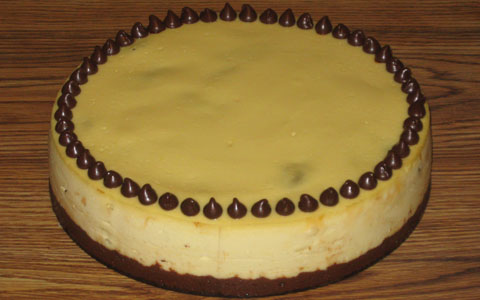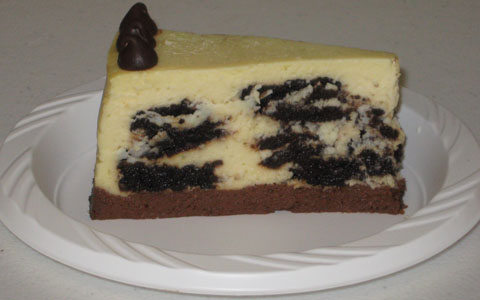|
|
 |
Baked Cookies+Creme Cheesecake—Prototype 8:
Yogurt Cheese:
Prepare ahead of time 3 pounds of yogurt cheese, derived from three 32-ounce
containers of nonfat yogurt. If the resulting yogurt cheese falls below 48
ounces, add back enough of the whey (that was strained out from the yogurt) to
make up the difference.
Crust:
4 oz. semi-sweet chocolate, melted
2 tablespoons cocoa powder
8 oz. (1 cup) yogurt cheese (see above)
3/8 cup granulated sugar
1 teaspoon vanilla
2 oz. finely ground Bran Buds
Place all this into a 9 or 9 1/2 inch springform pan.
Batter:
4 tablespoons melted or softened butter
1 1/4 cups granulated sugar
1/4 cup all-purpose flour
3 tablespoons arrowroot
1/2 teaspoon salt
40 oz. (5 cups) yogurt cheese (see above)
2 teaspoons vanilla
4 eggs
Cookies:
1 package, a 12-ounce size or—if package is a different size—12
ounces, of chocolate sandwich cookies, broken preferably in halves (Back To
Nature Classic Creme Cookies are recommended—not only for their great,
all-natural taste, but these were found in 12-ounce packages)
Expect about 7 cups of the resulting batter, but do not add this to the pan all
at once. Rather, this needs to be done in five installments. Wrap the pan in
foil just before adding the first installment. Minimize the foil's disturbance
in order to minimize its leakage risk.
For each of the first four installments, add about 1 1/2 cups of batter and one
fourth of the cookies to the pan. There is no need to be exact—evenly
distributing the cookies is the intent here. Because of this, use extra care in
the later installments when adding contents (i.e., do it gently) to the pan.
Ensure that the cookies are fully coated, and immersed as much as possible.
After adding the installment, bake the pan with its contents for 15 minutes. For
each of the first three installments, bake at 325 degrees. For the fourth
installment, reduce the temperature and bake at 300 degrees. For all four
installments here, bake with the pan in a tub filled with at least 1/4 to 1/2
inch of boiling water, but (to reduce spillage risks) do not fill the tub all
the way at this point, because the whole tub-and-pan assembly is going to need
to be removed from the oven (in order to comfortably add contents to the pan)
between installments.
After all this is done, there should be about a cup of batter but no cookies
remaining, with 60 minutes of baking time reached at this point (15 minutes for
each of the first four installments). Now comes the fifth installment—carefully
add the last of this batter on top of the pan's other contents. Try to fully
coat the entire surface, especially wherever cookie pieces may be showing. Next,
return the entire pan-and-tub assembly to the oven. At this point, fill up the
tub generously with boiling water. Resume baking at 300 degrees for another 55
minutes (based upon usage of a 9 1/2" pan).
Afterward, shut the oven off, and leave its door slightly ajar, with the
cheesecake still inside—and in the tub—for an hour. Next, remove the
cheesecake from the oven and tub, and—if desired—add a border of
chocolate chips around the edge of this cheesecake. Continue to cool it down at
room temperature for another two hours. After doing so, remove the cheesecake
from pan and refrigerate.


|
|

|


